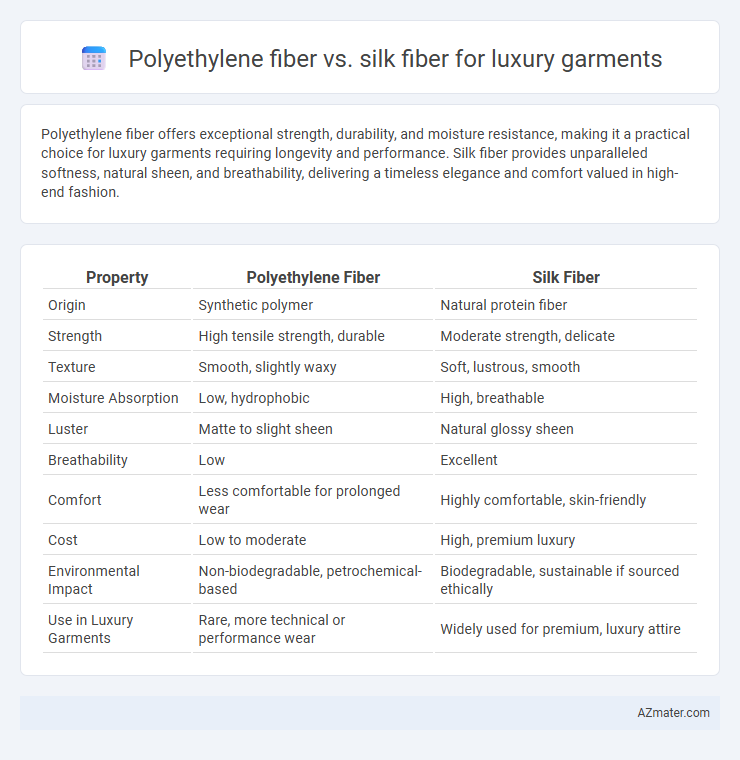Polyethylene fiber offers exceptional strength, durability, and moisture resistance, making it a practical choice for luxury garments requiring longevity and performance. Silk fiber provides unparalleled softness, natural sheen, and breathability, delivering a timeless elegance and comfort valued in high-end fashion.
Table of Comparison
| Property | Polyethylene Fiber | Silk Fiber |
|---|---|---|
| Origin | Synthetic polymer | Natural protein fiber |
| Strength | High tensile strength, durable | Moderate strength, delicate |
| Texture | Smooth, slightly waxy | Soft, lustrous, smooth |
| Moisture Absorption | Low, hydrophobic | High, breathable |
| Luster | Matte to slight sheen | Natural glossy sheen |
| Breathability | Low | Excellent |
| Comfort | Less comfortable for prolonged wear | Highly comfortable, skin-friendly |
| Cost | Low to moderate | High, premium luxury |
| Environmental Impact | Non-biodegradable, petrochemical-based | Biodegradable, sustainable if sourced ethically |
| Use in Luxury Garments | Rare, more technical or performance wear | Widely used for premium, luxury attire |
Introduction to Polyethylene and Silk Fibers
Polyethylene fiber, known for its exceptional strength-to-weight ratio and moisture resistance, is increasingly utilized in luxury garments for durability and performance. Silk fiber, prized for its natural sheen, softness, and breathability, remains a top choice in high-end fashion for its elegance and comfort. Each fiber offers distinct advantages, with polyethylene excelling in robustness and silk providing unparalleled luxury and tactile appeal.
Origins and Production Processes
Polyethylene fiber, derived from polymerizing ethylene monomers through methods like gel spinning, originates from synthetic petrochemical sources, offering high tensile strength and durability ideal for luxury garment applications demanding performance and resilience. Silk fiber, sourced from the sericulture of Bombyx mori silkworms, involves harvesting and reeling natural protein filaments, prized for its smooth texture, luster, and breathability, making it a traditional choice in high-end fashion. The production of polyethylene fibers involves advanced chemical engineering processes, whereas silk production relies on biological cultivation and skilled manual labor, influencing the cost, feel, and sustainability profile of luxury textiles.
Physical Properties Comparison
Polyethylene fiber exhibits high tensile strength, excellent abrasion resistance, and low moisture absorption, making it durable and lightweight for luxury garments, whereas silk fiber offers superior elasticity, natural sheen, and excellent moisture wicking, providing a luxurious feel and comfort. Polyethylene's hydrophobic nature results in less breathability compared to silk, which is naturally breathable and temperature regulating, ideal for high-end apparel. In terms of thermal properties, silk can withstand moderate heat without deformation, while polyethylene has a higher melting point but is less resistant to prolonged heat exposure.
Aesthetic and Texture Differences
Polyethylene fiber offers a matte finish with a smooth, slightly stiff texture, creating a modern, minimalist aesthetic ideal for innovative luxury garments. Silk fiber provides a natural sheen and exceptionally soft, fluid drape, contributing to timeless elegance and rich tactile appeal favored in high-end fashion. The contrast in luster and hand feel between polyethylene and silk fibers distinctly influences garment visual impact and wearer comfort in luxury apparel.
Durability and Strength Analysis
Polyethylene fiber exhibits exceptional tensile strength and abrasion resistance, making it highly durable for luxury garments subjected to frequent wear and stress. Silk fiber, while prized for its natural luster and softness, is comparatively less durable, with lower tensile strength and higher susceptibility to abrasion and UV degradation. Choosing polyethylene fiber enhances garment longevity and structural integrity, especially in high-end fashion that demands both durability and aesthetic appeal.
Comfort and Breathability Factors
Polyethylene fiber offers high durability and moisture-wicking properties but lacks the natural breathability and softness of silk fiber, which excels in providing unmatched comfort and temperature regulation in luxury garments. Silk fiber's natural protein structure allows for excellent airflow and moisture absorption, enhancing breathability and skin comfort. Polyethylene's synthetic nature may lead to reduced comfort in prolonged wear compared to the luxurious, lightweight feel of silk fiber.
Sustainability and Environmental Impact
Polyethylene fiber, derived from petrochemicals, poses significant environmental challenges due to its non-biodegradable nature and reliance on fossil fuels, leading to higher carbon emissions compared to natural alternatives. Silk fiber, produced from silkworms, is biodegradable and renewable, making it a more sustainable choice for luxury garments despite requiring careful resource management during production. The environmental impact of silk is mitigated by its biodegradability and lower carbon footprint, whereas polyethylene fiber contributes to microplastic pollution and long-term waste accumulation.
Maintenance and Care Requirements
Polyethylene fiber in luxury garments offers high durability and moisture resistance, making maintenance straightforward with easy washing and quick drying properties. Silk fiber, prized for its natural luster and softness, demands delicate care including hand washing or dry cleaning to preserve its sheen and prevent damage. Choosing between these fibers depends on balancing the low-maintenance benefits of polyethylene with the elegant, high-care nature of silk suitable for premium apparel.
Cost Implications for Luxury Garments
Polyethylene fiber offers a cost-effective alternative to silk fiber in luxury garments, significantly reducing raw material expenses due to its synthetic origin and lower production costs. Silk fiber, prized for its natural luster and softness, commands higher prices because of labor-intensive sericulture and limited supply, thereby increasing overall garment cost. Luxury brands balancing budget constraints often weigh polyethylene's affordability against silk's premium aesthetic and tactile qualities in their cost structure analysis.
Choosing the Right Fiber for High-End Fashion
Polyethylene fiber offers exceptional durability, moisture resistance, and a lightweight structure, making it ideal for high-performance luxury garments requiring longevity and comfort. Silk fiber provides unmatched softness, natural sheen, and breathability, perfect for elegant, delicate fashion pieces emphasizing texture and aesthetic appeal. Selecting the right fiber depends on the desired balance between performance attributes and luxurious feel tailored to specific high-end fashion demands.

Infographic: Polyethylene fiber vs Silk fiber for Luxury garment
 azmater.com
azmater.com